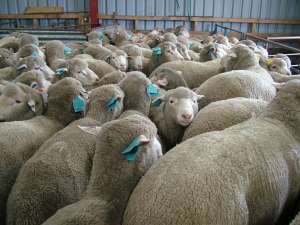Genetic Improvement Programme
Sheep production in the Falkland Islands is based on a self replacing flock producing meat and wool. In the past the key focus was on wool production with meat (mutton) being a secondary product sourced from older animals.
on wool production with meat (mutton) being a secondary product sourced from older animals.
A number of sheep breeds have been used over the Islands' 150 year plus farming history. For much of this time, the Corriedale was the breed that was considered the best fit for the climate and extensive grazing system of the Falkland Islands. First developed in New Zealand, the Corriedale is a Merino crossed with a Lincoln.
They are considered to be hardy, adapted to a wide range of conditions and slightly more fertile than the purebred Merinos. Essentially they are dual purpose producing strong wool (25 – 32 microns) and mutton. Ewes can be used as prime lamb mothers.
Over the past two decades and in line with global trends, the profitability of enterprises producing strong wool and mutton has been in decline. In response to these changing global economic conditions, the Falkland Islands Government embarked on a genetic improvement programme beginning in the early 1990's and continuing today. The programmes aim was to reduce the fibre diameter of the flock while maintaining fleece weight and bodyweight amongst other selection criteria.
The process used in the early stages of this programme was the importation of several hundred live Polwarth stud sheep, which formed the nucleus of the National Stud Flock (NSF). The NSF remains today and is a pedigree and performance recorded flock. The main selection criteria for animals is based on the key production traits of fibre diameter, fleece weight, bodyweight and fertility. This objective selection is combined with key visual assessments of structure, wool quality (style), face cover and pigmented fibres. A new production trait relating to internal parasite resistance was included in 2008.
The introduction of the NSF and the production of seedstock for the Falkland Island sheep industry have been instrumental in achieving a reduction in the average fibre diameter of the national flock from approximately 27.5 micron in 1990 to approximately 25 micron in 2008.
The process used in the latter stages of this programme has been to expand the breed base by introducing new breeds. This has included breeds such as Dohne Merino, South African Meat Merino (SAMM), Afrino, fine and medium wool Merinos, Cormos (comeback), Pool Dorset, Texel and Suffolk. The latest reproductive technologies of fresh and frozen embryo transfer (ET) along with laproscopic (AI) and cervical (CAI) artificial insemination have been used to propagate the breeds as quickly as possible and build sufficient critical mass for the Falkland Islands to be self sufficient. This has been done in response to changes within the domestic meat industry and the continued global trend towards finer fibre diameter. All animals used in the latter stage have been selected on their performance data (estimated breeding values when available) with a selection of the dual purpose breeds being monitored to measure their performance and adaptation to the Falkland Islands farming environment. The aim is to integrate the purebreds into the national flock to aid its future development by continuing its dual purpose production focus and provide the capability to produce lamb as well as mutton.

